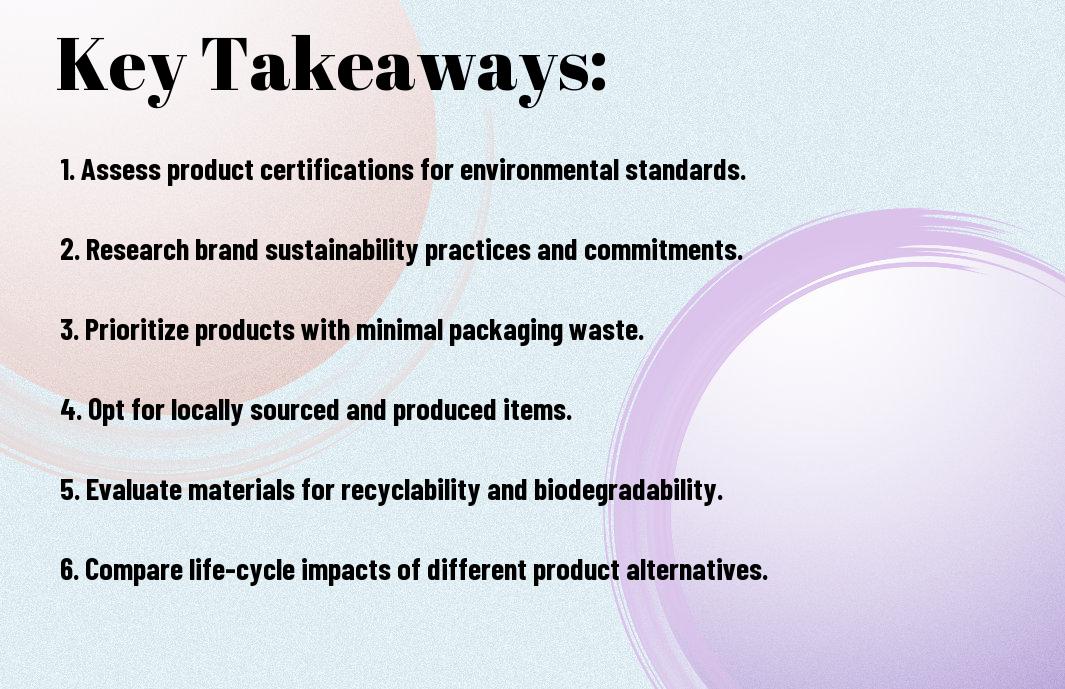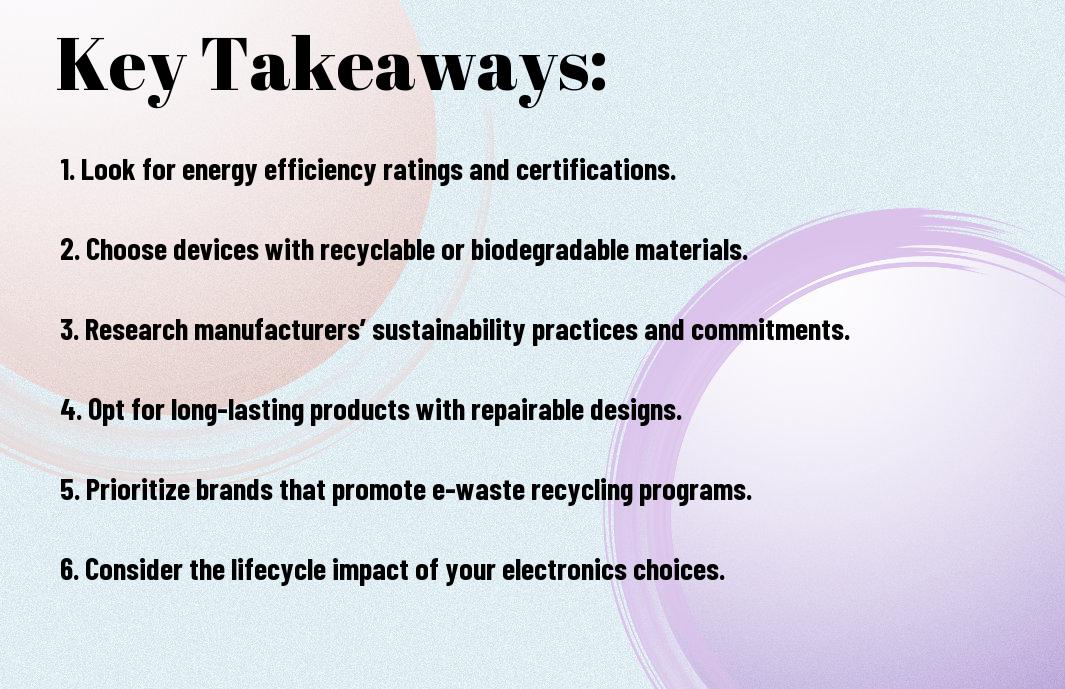As you strive to live a more sustainable lifestyle, you’re likely looking for ways to make environmentally friendly choices. Regarding selecting green products, you want to ensure that your purchases align with your values. You’ll need to evaluate the ingredients, packaging, and production processes of various products to determine their eco-friendliness. By doing so, you can make informed decisions that benefit both your health and the planet, and you can trust that your choices are supporting a more sustainable future.
Key Takeaways:
To make informed decisions when selecting eco-friendly products, consider the following points:
- Look for products with certified labels, such as the EPA Safer Choice label, which indicates that the product meets certain environmental standards.
- Check the ingredients and materials used in the product to ensure they are sustainable and non-toxic.
- Consider the lifecycle of the product, including its production, use, and disposal, to determine its overall environmental impact.
- Evaluate the company’s values and practices to ensure they align with your own environmental goals and values.
- Be aware of greenwashing, where companies make false claims about the environmental benefits of their products, and always verify the information through reliable sources.
Identifying Genuine Green Products
The process of identifying genuine green products involves careful consideration of various factors, including the product’s ingredients, manufacturing process, and packaging. You can start by looking for products that are made from sustainable materials, have minimal packaging, and are designed for recyclability or biodegradability. By doing so, you can make informed decisions that align with your values and contribute to a more sustainable future.
Eco-Labels and Certifications
Among the various eco-labels and certifications available, you should look for reputable ones that are backed by rigorous standards and third-party verification. You can trust products that carry labels such as Energy Star, USDA Organic, or Fair Trade, as they indicate a commitment to environmental and social responsibility.
Reading Between the Lines of Product Claims
Greener options often come with claims that sound appealing, but you need to be cautious of greenwashing. You should scrutinize the language used on the product label, looking for specific details about the product’s environmental benefits and any relevant certifications.
The key to reading between the lines of product claims is to be vigilant and critical. You should question vague terms like “eco-friendly” or “natural,” and instead, look for concrete evidence of the product’s sustainability features. By doing so, you can make more informed decisions and avoid falling prey to misleading marketing tactics, ultimately helping you to choose products that truly align with your values and contribute to a more sustainable future.

Evaluating Environmental Impact
There’s more to choosing green products than just looking for an eco-label. You need to consider the product’s overall environmental footprint, from production to disposal.
Considering the Product’s Lifecycle
Lifecycle assessments help you understand the environmental effects of a product at each stage, enabling you to make informed decisions about your purchases.
Assessing the Manufacturing Process
An analysis of the manufacturing process is vital to determine the product’s environmental impact, and you should look for information on the materials used, energy consumption, and waste generation.
Considering the details of the manufacturing process, you can evaluate the efforts made by the company to reduce its environmental footprint, such as using renewable energy sources, reducing water usage, or implementing recycling programs, which will help you make a more eco-friendly choice.
Making Informed Decisions
Your buying power can drive change, and choosing green products is a great place to start. By considering the environmental impact of your purchases, you can make a positive difference.
Weighing the Pros and Cons
On evaluating green products, you’ll want to weigh their advantages and disadvantages. The following Green Product Comparison table breaks it down:
| Pros | Cons |
|---|---|
| Eco-friendly materials | Higher cost |
| Sustainable production | Limited availability |
| Reduced waste | Performance concerns |
Comparing Similar Products
After researching green products, you’ll want to compare similar items. The following Product Comparison Table helps:
| Product | Environmental Impact |
|---|---|
| Product A | Low waste, biodegradable |
| Product B | High energy consumption |
It is vital to explore deeper into comparing similar products. The following Detailed Comparison table provides more insights:
| Feature | Product C |
|---|---|
| Materials | Sustainable, recycled |
| Manufacturing process | Energy-efficient, minimal waste |
Red Flags to Watch Out For
Despite your best intentions, it’s easy to get misled by false claims. You need to be vigilant when choosing green products to avoid falling prey to deceptive marketing tactics.
Greenwashing Tactics
Beneath the surface of eco-friendly claims, some companies employ misleading strategies to boost sales. You should look out for vague terms and unverified certifications that make a product seem more sustainable than it actually is.
Misleading Product Labels
Beside the attractive packaging, you’ll find labels that can be deceiving. You might see terms like “natural” or “biodegradable” without any clear explanation, making it difficult to gauge the product’s actual environmental impact.
Due to the lack of standardization in labeling, you may encounter products with misleading or exaggerated claims. You should always check for third-party certifications and investigate the manufacturer’s environmental policies to ensure that your purchase aligns with your values and contributes to a more sustainable future.
Benefits of Choosing Green Products
Unlike traditional products, green products offer numerous advantages. You can learn more about eco-friendly shopping by visiting Eco-friendly Shopping Tips: A Short Guide To Sustainable Living to make informed decisions.
Environmental Benefits
Around the time you start using green products, you’ll notice a significant reduction in your environmental footprint, as they are designed to be sustainable and eco-friendly.
Health and Economic Benefits
For your well-being and financial stability, choosing green products is an excellent decision, as they are often made from natural ingredients and can help you save money in the long run.
In fact, by opting for green products, you will not only improve your health by reducing exposure to harsh chemicals, but also support sustainable economies, which can lead to a more stable and prosperous future for you and your community.

Resources for Further Guidance
Keep in mind that choosing green products wisely requires ongoing education and research. You can find numerous resources to help you make informed decisions.
Reliable Sources of Information
Among the many available resources, government websites and non-profit organizations provide valuable information on environmentally friendly products and practices that you can trust.
Online Tools and Apps
An array of online tools and apps are available to help you evaluate and compare the environmental impact of various products, enabling you to make more sustainable choices.
Understanding the features and benefits of these online tools and apps will allow you to utilize them effectively in your search for green products, providing you with a more comprehensive understanding of your options and helping you to identify the most eco-friendly choices for your needs.
Summing up
Considering all points, you can make informed decisions when choosing green products. You will be able to evaluate your options and select products that align with your values and needs. By analyzing labels, researching brands, and understanding your impact, you can trust your choices and feel confident in your ability to make a positive difference with your purchases, ultimately contributing to a more sustainable future for your community and the environment. You will be supporting your own well-being and the well-being of the planet.
FAQ
Q: What are the key factors to consider when choosing green products?
A: When deciding on green products, it’s important to look for items that are made from sustainable materials, have minimal packaging, and are designed for recyclability or biodegradability. Additionally, consider the product’s energy efficiency, water usage, and whether it’s free from toxic chemicals. Checking for certifications like Energy Star or EcoLogo can also help ensure that the product meets certain environmental standards.
Q: How can I distinguish between genuinely eco-friendly products and those that are just “greenwashed”?
A: To avoid falling for “greenwashed” products, look beyond the marketing claims and examine the product’s ingredients, manufacturing process, and end-of-life disposal. Check for third-party certifications, read reviews from other customers, and research the company’s environmental policies and track record. Be wary of vague terms like “natural” or “eco-friendly” and opt for products with specific, quantifiable claims, such as “made from 100% post-consumer recycled materials” or “uses 50% less energy than traditional products.”
Q: Are green products always more expensive than their conventional counterparts, and is the extra cost worth it?
A: While some green products may be pricier than traditional ones, many are competitively priced, and some can even save you money in the long run. For example, energy-efficient appliances and LED light bulbs may cost more upfront but can lead to significant energy savings over time. Consider the product’s lifespan, maintenance requirements, and potential health benefits when evaluating the cost. Additionally, supporting green products can also contribute to a larger market shift towards sustainability, ultimately benefiting the environment and public health.

